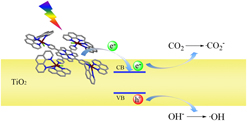Crossref Citations
This article has been cited by the following publications. This list is generated based on data provided by
Crossref.
Zhou, Rong-Hui
Wei, Zhi-He
Li, Yan-Yang
Li, Zhong-Jun
and
Yao, Hong-Chang
2019.
Construction of visible light–responsive Z-scheme CdS/BiOI photocatalyst with enhanced photocatalytic CO2 reduction activity.
Journal of Materials Research,
Vol. 34,
Issue. 23,
p.
3907.
Mu, Feihu
Zhou, Shijian
Wang, Yun
Wang, Jian
and
Kong, Yan
2019.
Bimetallic metal–organic frameworks-derived mesoporous CdxZn1−xS polyhedrons for enhanced photocatalytic hydrogen evolution.
Journal of Materials Research,
Vol. 34,
Issue. 10,
p.
1773.
Yin, Xiu-Ju
and
Zhu, Long-Guan
2019.
High-efficiency photocatalytic performance and mechanism of silver-based metal–organic framework.
Journal of Materials Research,
Vol. 34,
Issue. 6,
p.
991.
Prajapati, Pankaj Kumar
and
Jain, Suman L.
2019.
Synthesis and evaluation of CoPc grafted bismuth oxyhalide (Bi24O31Br10): a visible light-active photocatalyst for CO2 reduction into methanol.
Dalton Transactions,
Vol. 48,
Issue. 15,
p.
4941.
Yu, Chengtao
Zhang, Jingyi
Yang, Hexu
Zhang, Ling
and
Gao, Yu
2019.
Enhanced photovoltaic conversion efficiency of a dye-sensitized solar cell based on TiO2 nanoparticle/nanorod array composites.
Journal of Materials Research,
Vol. 34,
Issue. 07,
p.
1155.
Ding, Xiaodong
Wang, Wei
Zhang, Ao
Zhang, Lishan
and
Yu, Dan
2019.
Efficient visible light degradation of dyes in wastewater by nickel–phosphorus plating–titanium dioxide complex electroless plating fabric.
Journal of Materials Research,
Vol. 34,
Issue. 6,
p.
999.
Tian, Mengkun
Liu, Chenze
Ge, Jingxuan
Geohegan, David
Duscher, Gerd
and
Eres, Gyula
2019.
Recent progress in characterization of the core–shell structure of black titania.
Journal of Materials Research,
Vol. 34,
Issue. 07,
p.
1138.
He, Yu
He, Qiangrui
Liu, Zhihan
Wang, Oumin
and
Guli, Mina
2020.
Controllable preparation and improved performance of TiO2 photocatalysts with various structures.
Materials Technology,
Vol. 35,
Issue. 1,
p.
1.
Min Park, Jong
Lee, Jeong Heon
and
Jang, Woo-Dong
2020.
Applications of porphyrins in emerging energy conversion technologies.
Coordination Chemistry Reviews,
Vol. 407,
Issue. ,
p.
213157.
Liu, Lizhen
Wang, Shuobo
Huang, Hongwei
Zhang, Yihe
and
Ma, Tianyi
2020.
Surface sites engineering on semiconductors to boost photocatalytic CO2 reduction.
Nano Energy,
Vol. 75,
Issue. ,
p.
104959.
Puppin, Lara G.
Khalid, Mohd.
da Silva, Gelson T.T.
Ribeiro, Caue
Varela, Hamilton
and
Lopes, Osmando F.
2020.
Electrochemical reduction of CO2 to formic acid on Bi2O2CO3/carbon fiber electrodes.
Journal of Materials Research,
Vol. 35,
Issue. 3,
p.
272.
Tsymbal, D. O.
and
Mazanik, M. E.
2021.
Rationale for the use of photocatalysis for natural and drinking water purification from pollutants of biological origin.
Health and Ecology Issues,
Vol. 18,
Issue. 4,
p.
143.
Sahoo, Suman Sekhar
Mansingh, Sriram
Babu, Pradeepta
and
Parida, Kulamani
2021.
Black titania an emerging photocatalyst: review highlighting the synthesis techniques and photocatalytic activity for hydrogen generation.
Nanoscale Advances,
Vol. 3,
Issue. 19,
p.
5487.
Zhang, Hongling
Yan, Yanghao
Khan, Muhammad Asim
Xia, Mingzhu
Lei, Wu
and
Wang, Fengyun
2021.
Preparation of spherical filler-like ZnFe2O4/Bi2MoO6 surrounded by nanosheets and its photocatalytic applications.
Environmental Technology,
Vol. 42,
Issue. 13,
p.
2077.
Bhardwaj, Reva
Sharma, Tanvi
Nguyen, Dinh Duc
Cheng, Chin Kui
Lam, Su Shiung
Xia, Changlei
and
Nadda, Ashok Kumar
2021.
Integrated catalytic insights into methanol production: Sustainable framework for CO2 conversion.
Journal of Environmental Management,
Vol. 289,
Issue. ,
p.
112468.
Duan, Yonghua
Gou, Ming-Lei
Guo, Yafei
Cai, Junqing
Song, Wensheng
Liu, Zhen
and
Zhou, Erpeng
2021.
In situ hydrothermal synthesis of TiO2–RGO nanocomposites for 4-nitrophenol degradation under sunlight irradiation.
Journal of Materials Research,
Vol. 36,
Issue. 4,
p.
906.
Guli, Mina
Helmy, Elsayed T.
Schneider, Jenny
Lu, Gui
and
Pan, Jia Hong
2022.
Characterization Methodology and Activity Evaluation of Solar-Driven Catalysts for Environmental Remediation.
Topics in Current Chemistry,
Vol. 380,
Issue. 5,
Permporn, Darika
Khunphonoi, Rattabal
Wilamat, Jetsadakorn
Khemthong, Pongtanawat
Chirawatkul, Prae
Butburee, Teera
Sangkhun, Weradesh
Wantala, Kitirote
Grisdanurak, Nurak
Santatiwongchai, Jirapat
Hirunsit, Pussana
Klysubun, Wantana
and
de Luna, Mark Daniel G.
2022.
Insight into the Roles of Metal Loading on CO2 Photocatalytic Reduction Behaviors of TiO2.
Nanomaterials,
Vol. 12,
Issue. 3,
p.
474.
Rajeshwari, V
Vedhi, C
and
Fernando, Jessica
2022.
Dopamine sensor based on coreshell poly paraphenylene diamine/ titanium dioxide/ multiwalled carbon nanotube nanocomposite.
Materials Today: Proceedings,
Vol. 68,
Issue. ,
p.
287.
Nikoloudakis, Emmanouil
López-Duarte, Ismael
Charalambidis, Georgios
Ladomenou, Kalliopi
Ince, Mine
and
Coutsolelos, Athanassios G.
2022.
Porphyrins and phthalocyanines as biomimetic tools for photocatalytic H2production and CO2reduction.
Chemical Society Reviews,
Vol. 51,
Issue. 16,
p.
6965.
